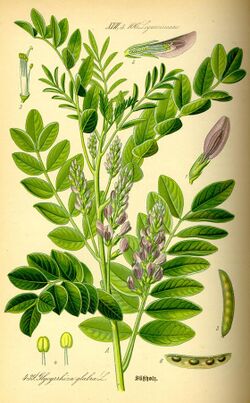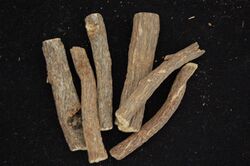Biology:Liquorice
| Liquorice | |
|---|---|

| |
| Scientific classification | |
| Kingdom: | Plantae |
| Clade: | Tracheophytes |
| Clade: | Angiosperms |
| Clade: | Eudicots |
| Clade: | Rosids |
| Order: | Fabales |
| Family: | Fabaceae |
| Subfamily: | Faboideae |
| Clade: | Inverted repeat-lacking clade |
| Genus: | Glycyrrhiza |
| Species: | G. glabra
|
| Binomial name | |
| Glycyrrhiza glabra | |
| Synonyms[2][3][4] | |
| |
Liquorice (British English) or licorice (American English; IPA: /ˈlɪkərɪʃ, -ɪs/ LIK-ər-ish, -iss)[5][6] is the common name of Glycyrrhiza glabra, a flowering plant of the bean family Fabaceae, from the root of which a sweet, aromatic flavouring is extracted.[7]
The liquorice plant is an herbaceous perennial legume native to Western Asia, North Africa, and Southern Europe.[1] Liquorice is used as a flavouring in confectionery, tobacco, beverages, and pharmaceuticals, and is marketed as a dietary supplement.[7][8]
Liquorice extracts have been used in herbalism and traditional medicine.[7] Excessive consumption of liquorice (more than 2 mg/kg [3.2×10−5 oz/lb] per day of pure glycyrrhizinic acid, a liquorice component) may result in adverse effects, with overconsumption suspected clinically in people presenting with otherwise unexplained hypertension, low blood potassium, and muscle weakness.[7][8][9] Consuming licorice should be avoided during pregnancy.[8]
Etymology
The word liquorice, or licorice, is derived via the Anglo-French lycorys, from Late Latin liquiritia,[10] itself ultimately derived from Greek Ancient Greek: (the Modern Greek spelling of the genus is γλυκόριζα, glykoriza)[11] literally meaning 'sweet root' and referring to Glycyrrhiza glabra.[12]
The latter gives the plant binomial name with glabra meaning smooth[13] and referring to the plant's smooth husks; the former came to being via the influence of liquere, 'to become fluid', reflecting the method of extracting the sweet component from the roots.[14]
(As of 2021), its English common name is spelled 'liquorice' in most of the Commonwealth, but 'licorice' is also used in some countries.[7][15][16]
Description
Liquorice is a herbaceous perennial, growing to 1 metre (40 in) in height, with pinnate leaves about 7–15 cm (3–6 in) long, with 9–17 leaflets. The flowers are 8–12 mm (5⁄16–1⁄2 in) long, purple to pale whitish blue, produced in a loose inflorescence. The fruit is an oblong pod, 20–30 mm (3⁄4–1 1⁄8 in) long, containing several seeds.[17] The roots are stoloniferous.[18]
Chemistry

Liquorice root contains triterpenoids, polyphenols, and polysaccharides.[8] Flavonoids account for the yellow root color.[8] The principal glycoside, glycyrrhizin, exists in content of 7% to 10%, depending on cultivation practices.[8] The isoflavene glabrene and the isoflavane glabridin, found in the roots of liquorice, are phytoestrogens.[19][20]
The scent of liquorice root comes from a complex and variable combination of compounds, of which anethole is some 3% of total volatiles.[citation needed] Much of the sweetness in liquorice comes from glycyrrhizin, which has 30–50 times the sweetness of sugar.[citation needed] The sweetness is different from sugar, being less instant, tart, and lasting longer.
Cultivation and uses
Liquorice grows best in well-drained soils in deep valleys with full sun. It is harvested in the autumn two to three years after planting.[17] Countries producing liquorice include Turkey, Greece, Iran, and Iraq.[8]
Tobacco
Liquorice is used as a flavouring agent for tobacco, for flavour-enhancing and moistening agents in the manufacture of American blend cigarettes, moist snuff, chewing tobacco, and pipe tobacco.[7][8][21] Liquorice provides tobacco products with a natural sweetness and a distinctive flavour that blends readily with the natural and imitation flavouring components employed in the tobacco industry.[8] Liquorice can also be added to cigarette rolling papers. (As of 2009), the US Food and Drug Administration banned the use of any "characterizing flavors" other than menthol from cigarettes, but not other manufactured tobacco products.[22]
Food and confectionery
Liquorice flavour is found in a wide variety of candies or sweets. In most of these candies, the taste is reinforced by aniseed oil so the actual content of liquorice is low.
In the Netherlands, liquorice confectionery (drop) is a common sweet sold in many forms. Mixing it with mint, menthol, aniseed, or laurel is common. It is also mixed with ammonium chloride (salmiak); salmiak liquorice in the Netherlands is known as zoute drop ('salty liquorice'). Strong, salty sweets are also consumed in Nordic countries where liquorice flavoured alcohols are sold, particularly in Denmark and Finland.[citation needed]
Dried sticks of the liquorice root are a traditional confectionery in the Netherlands as were they once in Britain. They were sold simply as sticks of zoethout ('sweet wood') to chew on as a candy.
Pontefract in Yorkshire, England, is where liquorice mixed with sugar began to be used as a sweet in the contemporary way.[23] Pontefract cakes were originally made there.[24] In Cumbria, County Durham, Yorkshire and Lancashire, it is colloquially known as 'Spanish', supposedly because Spanish monks grew liquorice root at Rievaulx Abbey near Thirsk.[25]
In Italy, Spain and France, liquorice is used in its natural form. The root of the plant is simply harvested, washed, dried, and chewed as a mouth freshener. Throughout Italy, unsweetened liquorice is consumed in the form of small black pieces made only from 100% pure liquorice extract. In Calabria, a liqueur is made from pure liquorice extract and in Reggio Emilia a soft drink called acqua d'orcio is made. Liquorice is also used in Syria and Egypt.
In southeastern Turkey, such as in Diyarbakır, licorice root is traditionally made into a chilled beverage that is most commonly consumed in summer.[26]
Research
Properties of glycyrrhizin are under preliminary research, such as for hepatitis C or topical treatment of psoriasis, but the low quality of studies (As of 2017) prevents conclusions about efficacy and safety.[7][8][27]
Traditional medicine
In traditional Chinese medicine, a related species G. uralensis (often translated as "liquorice") is known as gancao (Chinese: 甘草; literally: 'sweet grass'), and is believed to "harmonize" the ingredients in a formula.[28] although there is no high-quality clinical research to indicate it is safe or effective for any medicinal purpose. The European Medical Agency added liquorice to their list of herbal medicine.[29]
Fungicide
The essential oils inhibit the growth of Aspergillus flavus.[30]
Adverse effects
Consumption levels
The United States Food and Drug Administration regards that foods containing liquorice and its derivatives (including glycyrrhizin) are generally recognized as safe for use as a food ingredient, if not consumed excessively.[7][8][9] Other jurisdictions have suggested no more than 100–200 mg (1.5–3.1 grains) of glycyrrhizin per day, the equivalent of about 70–150 g (2 1⁄2–5 1⁄4 oz) of liquorice confectionery.[9] Although liquorice is considered safe as a food ingredient, it can cause serious side effects if consumed in large amounts (above 0.2 mg per kg per day).[7][8][9] One estimate is that a normal healthy person can consume 10 mg (0.15 grains) of glycyrrhizic acid per day.[31]
Because the composition of liquorice extracts in various products may exist in a broad range, there is not enough scientific information to determine that a specific level of intake is safe or unsafe.[7][8]
Physiological effects
The effects of excessive liquorice consumption on lowering potassium levels in the blood and increasing blood pressure are a particular concern for people with hypertension (high blood pressure) or heart or kidney disease.[7]
Some adverse effects of liquorice consumed in amounts of 50 to 200 g per day over four weeks appear to be caused by glycyrrhizic acid (75 to 540 mg per day glycyrrhetinic acid) causing increases in blood pressure.[8] Consuming large amounts of liquorice during pregnancy has been associated with premature birth and health problems in the child.[8]
Hyper-mineralocorticosteroid syndrome can occur when the body retains sodium, and loses potassium, altering biochemical and hormonal regulation.[9] Some of these activities may include raised aldosterone levels, decline of the renin-angiotensin system and increased levels of the atrial natriuretic hormone in order to compensate the variations in homoeostasis.[9][32]
Other adverse effects may include electrolyte imbalance, edema, increased blood pressure, weight gain, heart problems, and weakness. Symptoms depend on the severity of toxicity. Some other complaints include fatigue, shortness of breath, kidney failure, and paralysis.[33][34]
Potential for toxicity
The major dose-limiting toxicities of liquorice are corticosteroid in nature, because of the inhibitory effect that its chief active constituents, glycyrrhizin and enoxolone, have on cortisol degradation, and include edema, hypokalaemia, weight gain or loss, and hypertension.[8][9][35][36]
Gallery
References
- ↑ 1.0 1.1 {{citation | mode = cs1 | title = Liquorice | work = Germplasm Resources Information Network (GRIN) | url = | publisher = [[Organization:Agricultural Research ServAgricultural Research Service (ARS), United States Department of Agriculture (USDA) | access-date = 6 March 2008 }}
- ↑ "The Plant List: A Working List of All Plant Species". http://www.theplantlist.org/tpl1.1/record/ild-7886.
- ↑ "Glycyrrhiza pallida Boiss., Diagn. Pl. Orient. ser. 2, 2: 22 (1856)". https://www.ipni.org/n/496964-1.
- ↑ "Glycyrrhiza violacea Boiss., Diagn. Pl. Orient. ser. 2, 2: 23 (1856)". https://www.ipni.org/n/496975-1.
- ↑ "Liquorice". Dictionary.com Unabridged. Random House. https://www.dictionary.com/browse/Liquorice.
- ↑ "Licorice". Dictionary.com Unabridged. Random House. https://www.dictionary.com/browse/Licorice.
- ↑ 7.00 7.01 7.02 7.03 7.04 7.05 7.06 7.07 7.08 7.09 7.10 "Licorice root". National Center for Complementary and Integrative Health, US National Institutes of Health. August 2020. https://nccih.nih.gov/health/licoriceroot.
- ↑ 8.00 8.01 8.02 8.03 8.04 8.05 8.06 8.07 8.08 8.09 8.10 8.11 8.12 8.13 8.14 8.15 "Licorice". Drugs.com. 31 January 2022. https://www.drugs.com/npp/licorice.html.
- ↑ 9.0 9.1 9.2 9.3 9.4 9.5 9.6 "Licorice abuse: time to send a warning message". Therapeutic Advances in Endocrinology and Metabolism 3 (4): 125–38. August 2012. doi:10.1177/2042018812454322. PMID 23185686.
- ↑ Bradley, Henry, ed (1908). "Liquorice, licorice" (in en). A New English Dictionary On Historical Principles (NED). VI. L to N. Oxford, England: Clarendon Press. p. 332. https://archive.org/details/oed6aarch/page/n345/mode/1up. Retrieved 2021-04-07.
- ↑ "γλυκύρριζα" (in el). Center for the Greek Language. Portal for the greek language. https://www.greek-language.gr/greekLang/medieval_greek/kriaras/search.html?lq=%CE%B3%CE%BB%CF%85%CE%BA%CF%8D%CF%81%CF%81%CE%B9%CE%B6%CE%B1&dq=.
- ↑ γλυκύρριζα. Liddell, Henry George; Scott, Robert; A Greek–English Lexicon at the Perseus Project.
- ↑ glabra. Charlton T. Lewis and Charles Short. A Latin Dictionary on Perseus Project.
- ↑ Harper, Douglas. "Licorice". Online Etymology Dictionary. https://www.etymonline.com/?term=Licorice.
- ↑ "Liquorice". Merriam-Webster Dictionary. https://www.merriam-webster.com/dictionary/Liquorice.
- ↑ "Licorice". Merriam-Webster Dictionary. https://www.merriam-webster.com/dictionary/Licorice.
- ↑ 17.0 17.1 Huxley, A., ed. (1992). New RHS Dictionary of Gardening. ISBN:0-333-47494-5
- ↑ Brown, D., ed. (1995). "The RHS encyclopedia of herbs and their uses". ISBN:1-4053-0059-0
- ↑ Somjen, D.; Katzburg, S.; Vaya, J.; Kaye, A. M.; Hendel, D.; Posner, G. H.; Tamir, S. (2004). "Estrogenic activity of glabridin and glabrene from licorice roots on human osteoblasts and prepubertal rat skeletal tissues". The Journal of Steroid Biochemistry and Molecular Biology 91 (4–5): 241–246. doi:10.1016/j.jsbmb.2004.04.008. PMID 15336701.
- ↑ Tamir, S.; Eizenberg, M.; Somjen, D.; Izrael, S.; Vaya, J. (2001). "Estrogen-like activity of glabrene and other constituents isolated from licorice root". The Journal of Steroid Biochemistry and Molecular Biology 78 (3): 291–298. doi:10.1016/S0960-0760(01)00093-0. PMID 11595510.
- ↑ Erik Assadourian, Cigarette Production Drops , Vital Signs 2005, at 70.
- ↑ "Flavored Tobacco". US Food and Drug Administration. 22 September 2009. https://www.fda.gov/TobaccoProducts/Labeling/ProductsIngredientsComponents/ucm2019416.htm.
- ↑ "Right good food from the Ridings". AboutFood.com. 25 October 2007. http://www.aboutfood.co.uk/places/yorkshire_guide.html.
- ↑ "The strange story of Britain's oldest sweet". BBC Travel. 2019-07-11. http://www.bbc.com/travel/story/20190710-the-strange-story-of-britains-oldest-sweet.
- ↑ "Where Liquorice Roots Go Deep". Northern Echo. 13 September 2006. http://www.thenorthernecho.co.uk/news/918508.where_liquorice_roots_go_deep/.
- ↑ "Lemon, Licorice and Sumac Sherbet: Drinks to beat the Summer Heat". Mediterranean Observer. 22 August 2021. https://mediterranean.observer/lemon-licorice-and-sumac-sherbet-drinks-to-beat-the-summer-heat/.
- ↑ Yu, J. J; Zhang, C. S; Coyle, M. E; Du, Y; Zhang, A. L; Guo, X; Xue, C. C; Lu, C (2017). "Compound glycyrrhizin plus conventional therapy for psoriasis vulgaris: A systematic review and meta-analysis of randomized controlled trials". Current Medical Research and Opinion 33 (2): 279–287. doi:10.1080/03007995.2016.1254605. PMID 27786567.
- ↑ Bensky, Dan (2004). Chinese Herbal Medicine: Materia Medica, Third Edition. Eastland Press. ISBN 978-0-939616-42-8.
- ↑ "Liquiritiae radix". European Medicines Agency. https://www.ema.europa.eu/en/medicines/herbal/liquiritiae-radix#consultation-section.
- ↑ Mamedov, Nazim A.; Egamberdieva, Dilfuza (2019). "Phytochemical Constituents and Pharmacological Effects of Licorice: A Review". Plant and Human Health, Volume 3. Cham: Springer Publishing. pp. 1–21. doi:10.1007/978-3-030-04408-4_1. ISBN 978-3-030-04407-7.
- ↑ Størmer, F.C.; Reistad, R.; Alexander, J. (1993). "Glycyrrhizic acid in liquorice—Evaluation of health hazard". Food and Chemical Toxicology 31 (4): 303–312. doi:10.1016/0278-6915(93)90080-I. ISSN 0278-6915. PMID 8386690.
- ↑ Mackenzie, Marius A.; Hoefnagels, Willibrord H. L.; Jansen, Renè W. M. M.; Benraad, Theo J.; Kloppenborg, Peter W. C. (1990). "The Influence of Glycyrrhetinic Acid on Plasma Cortisol and Cortisone in Healthy Young Volunteers". The Journal of Clinical Endocrinology & Metabolism 70 (6): 1637–1643. doi:10.1210/jcem-70-6-1637. ISSN 0021-972X. PMID 2161425.
- ↑ Blachley, Jon D.; Knochel, James P. (1980). "Tobacco Chewer's Hypokalemia: Licorice Revisited". New England Journal of Medicine 302 (14): 784–785. doi:10.1056/NEJM198004033021405. ISSN 0028-4793. PMID 6986557.
- ↑ Toner, J. M.; Ramsey, L. E. (1985). "Liquorice can damage your health". Practitioner 229 (1408): 858–860. PMID 4059165.
- ↑ Olukoga, A; Donaldson, D (June 2000). "Liquorice and its health implications.". The Journal of the Royal Society for the Promotion of Health 120 (2): 83–9. doi:10.1177/146642400012000203. PMID 10944880.
- ↑ Armanini, D; Fiore, C; Mattarello, MJ; Bielenberg, J; Palermo, M (September 2002). "History of the endocrine effects of licorice.". Experimental and Clinical Endocrinology & Diabetes 110 (6): 257–61. doi:10.1055/s-2002-34587. PMID 12373628.
External links
| Wikimedia Commons has media related to Liquorice. |
- Glycyrrhiza glabra (licorice), Kew plant profile
- What's That Stuff?: Licorice, Chemical & Engineering News
Wikidata ☰ Q257106 entry
 |










